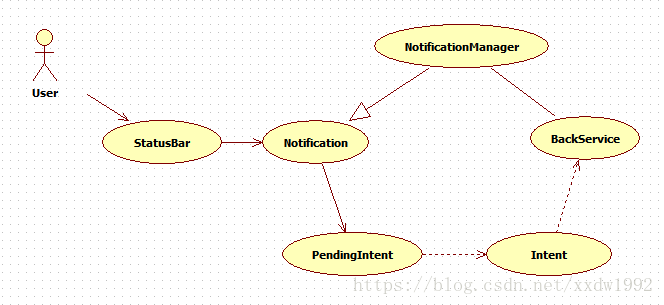PendingIntent详解
PendingIntent可以看作是对Intent的一个封装,但它不是立刻执行某个行为,
而是满足某些条件或触发某些事件后才执行指定的行为。
PendingIntent的获取
PendingIntent获取有三种方式:通过Activity,Service,BroadcastReceiver获取.
1. 你可以通过getActivity(Context context, int requestCode, Intent intent, int flags)系列方法从系统 取得一个用于启动一个Activity的PendingIntent对象.
2.可以通过getService(Context context, int requestCode, Intent intent, int flags)方法从系统取得一个 用于启动一个Service的PendingIntent对象.
3.可以通过getBroadcast(Context context, int requestCode, Intent intent, int flags)方法从系统取得一个用于向BroadcastReceiver的发送广播的PendingIntent对象.
PendingIntent的参数说明
拿第三种方式,广播的形式说明下
PendingIntent sentIntent = PendingIntent.getBroadcast(this, 0,sIntent, 0);
第一个参数是上下文.
第二个参数是每次requestcode不同,就能产生多个Pendingintent.
第三个参数是用来存储信息.
第四个参数是对不同操作作标识.
getBroadcast(Context context, int requestCode, Intent intent, int flags)中的flags有几种状态:
1.FLAG_CANCEL_CURRENT:如果AlarmManager管理的PendingIntent已经存在,那么将会取消当前的PendingIntent,从而创建一个新的PendingIntent.
2.FLAG_UPDATE_CURRENT:如果AlarmManager管理的PendingIntent已经存在,让新的Intent更新之前Intent对象数据,
例如更新Intent中的Extras,另外,我们也可以在PendingIntent的原进程中调用PendingIntent的cancel ()把其从系统中移除掉
3.FLAG_NO_CREATE:如果AlarmManager管理的PendingIntent已经存在,那么将不进行任何操作,若描述的Intent不存直接返回NULL(空).
4.FLAG_ONE_SHOT:该PendingIntent只作用一次.在该PendingIntent对象通过send()方法触发过后,PendingIntent将自动调用cancel()进行销毁,那么如果你再调用send()方法的话将会失败,系统将会返回一个SendIntentException.
Intent 是及时启动,intent 随所在的activity 消失而消失。
a. Intent是立即使用的,而PendingIntent可以等到事件发生后触发,PendingIntent可以cancel
b. Intent在程序结束后即终止,而PendingIntent在程序结束后依然有效
c. PendingIntent自带Context,而Intent需要在某个Context内运行
d. Intent在原task中运行,PendingIntent在新的task中运行
PendingIntent 是对真实Intent的一种封装载体,可以用来在出发时,根据Intent 唤起目标组件,如 Activity,Service,BroadcastReceiver 等。
例如,一般的推广行为:接收后台推送消息,并展示在通知栏上,当用户点击消息通知后,唤起指定的目标:
1. Intent intent = new Intent(action);
2. PendingIntent pendingIntent = PendingIntent.
getActivity(context, 0, intent, PendingIntent.FLAG_UPDATE_CURRENT);
对于一次性行为,上面的实现没有问题,但对于持续性的操作,问题就来了。
什么是持续性的操作?简单的例子就是,想豆瓣音乐客户端在通知栏上显示的那种,我称它作”远程交互“。
作为开发者,我们只需要关注模型中的 Notification 和 BackService 即可。当发生用户交互,通知栏上的通知视图会触发PendingIntent,并将其包含的Intent传到BackService,然后BackService根据具体的逻辑,更新对应的Notification视图,同时绑定新的PendingIntent,对应的代码如下:
Java代码
1. PendingIntent pendingIntent = PendingIntent.getService(context, 0, intent,
PendingIntent.FLAG_UPDATE_CURRENT);
为了使得新的PendingIntent生效,我们还特地设置Flag为 PendingIntent.FLAG_UPDATE_CURRENT,ok,现在这一切都没问题。
那我们稍稍把问题在搞复杂一点,我希望PendingIntent中的Intent带上参数,像这样:
Java代码
1. Intent intent = new Intent(action);
2. intent.putExtra("data", parcelable);
然后就用PendingIntent封装,然后你再去点击具体的通知-->触发,并在代码中试图取回设置好的 data 时,你会发现取到的data有问题----点击多于二次(或者点击第 2+ 个通知)时,data的值保持不变(和第一个通知,点击第一次取得的值一致)!
Why?
一般性而言,我们都会选择 FLAG_UPDATE_CURRENT,直接更新当前存在的PendingIntent,以提高性能。对于FLAG_UPDATE_CURRENT 的意义解析,指出 keep it but its replace its extra data with what is in this new Intent ,这里就是全文的关键点----PendingIntent的陷阱之在!!!
对于上文中的字面意思,如果判断为新Intent,则会更新对应的extra data,但是系统是如何判定新Intent的?Object.equals?Intent.filterEquals!但是从源码分析,filrerEquals 比较拥有同样的Action,不一样的data的 Intent 必定是返回false的,那问题还会出在哪呢?
不好意思,我们还漏了一个参数:requestCode,但是doc上明写着:currently not used。类比Activity.startActivityForResult(Content content, Class cls, int resquestCode)得知,resquestCode也是请求的唯一标志!
之后尝试一下的逻辑代码:
Intent intent = new Intent(action);
intent.putExtra("data", parcelable); PendingIntent pendingIntent =
PendingIntent.getService(context, UUID.randomUUID().hashCode(),
intent, PendingIntent.FLAG_UPDATE_CURRENT);
结果不言而喻......其实从getService的源码实现可以看出一点端倪:
Java代码
1. public static PendingIntent getService(Context context, int requestCode,
2. Intent intent, int flags) {
3. String packageName = context.getPackageName();
4. String resolvedType = intent != null ? intent.resolveTypeIfNeeded(
5. context.getContentResolver()) : null;
6. try {
7. intent.setAllowFds(false);
8. IIntentSender target =
9. ActivityManagerNative.getDefault().getIntentSender(
10. ActivityManager.INTENT_SENDER_SERVICE, packageName,
11. null, null, requestCode, new Intent[] { intent },
12. resolvedType != null ? new String[] { resolvedType } : null,
13. flags, null, UserHandle.myUserId());
14. return target != null ? new PendingIntent(target) : null;
15. } catch (RemoteException e) {
16. }
17. return null;
18. }
PendingIntent其实也是对 IItentSender 的一个封装,那就意味着,在更新 PendingIntent 时,系统比较的应该是 IIntentSender,从那一大串“构造参数”来看,requestCode也在其中,这关系就脱不了了。
Android的状态栏通知(Notification)
如果需要查看消息,可以拖动状态栏到屏幕下方即可查看消息。
步骤:
1获取通知管理器NotificationManager,它也是一个系统服务
2建立通知Notification notification = new Notification(icon, null, when);
3为新通知设置参数(比如声音,震动,灯光闪烁)
4把新通知添加到通知管理器
发送消息的代码如下:
//获取通知管理器
NotificationManager mNotificationManager =
(NotificationManager) getSystemService(Context.NOTIFICATION_SERVICE)
int icon = android.R.drawable.stat_notify_chat;
long when = System.currentTimeMillis();//通知发生的时间为系统当前时间
//新建一个通知,指定其图标和标题
Notification notification = new Notification(icon, null, when);//第一个参数为图标,第二个参数为短暂提示标题,第三个为通知时间
notification.defaults = Notification.DEFAULT_SOUND;//发出默认声音
notification.flags |= Notification.FLAG_AUTO_CANCEL;//点击通知后自动清除通知
Intent openintent = new Intent(this, OtherActivity.class);
PendingIntent contentIntent = PendingIntent.getActivity(this, 0, openintent, 0);//当点击消息时就会向系统发送openintent意图
notification.setLatestEventInfo(this, “标题”, “我是内容", contentIntent);
mNotificationManager.notify(0, notification);//第一个参数为自定义的通知唯一标识
重点是setLatestEventInfo( )方法的最后一个参数!!!!它是一个PendingIntent!!!!!!!!!
这里使用到了PendingIntent(pend本意是待定,不确定的意思)
PendingIntent可以看作是对Intent的包装。PendingIntent主要持有的信息是它所包装的Intent和当前Application的Context。正由于PendingIntent中保存有当前Application的Context,使它赋予带他程序一种执行的Intent的能力,就算在执行时当前Application已经不存在了,也能通过存在PendingIntent里的Context照样执行Intent。
PendingIntent的一个很好的例子:
SmsManager的用于发送短信的方法:
sendTextMessage(destinationAddress, scAddress, text, sentIntent, deliveryIntent);
第一个参数:destinationAddress对方手机号码
第二个参数:scAddress短信中心号码一般设置为空
第三个参数:text短信内容
第四个参数:sentIntent判断短信是否发送成功,如果你没有SIM卡,或者网络中断,则可以通过这个itent来判断。注意强调的是“发送”的动作是否成功。那么至于对于对方是否收到,另当别论
第五个参数:deliveryIntent当短信发送到收件人时,会收到这个deliveryIntent。即强调了“发送”后的结果
就是说是在"短信发送成功"和"对方收到此短信"才会激活 sentIntent和deliveryIntent这两个Intent。这也相当于是延迟执行了Intent
上面两个例子可以理解,PendingIntent就是一个可以在满足一定条件下执行的Intent,它相比于Intent的优势在于自己携带有Context对象,这样他就不必依赖于某个activity才可以存在。
短信系统举例代码
private final static String SEND_ACTION = "send";private final static String DELIVERED_ACTION = "delivered";
private void sendSms(String receiver, String text) {
SmsManager s = SmsManager.getDefault();
PendingIntent sentPI = PendingIntent.getBroadcast(this, 0, new Intent(SEND_ACTION),
PendingIntent.FLAG_CANCEL_CURRENT);
PendingIntent deliveredPI = PendingIntent.getBroadcast(this, 0, new Intent(DELIVERED_ACTION),
PendingIntent.FLAG_CANCEL_CURRENT);
// 发送完成
registerReceiver(new BroadcastReceiver() {
@Override
public void onReceive(Context context, Intent intent) {
switch (getResultCode()) {
case Activity.RESULT_OK:
Toast.makeText(getBaseContext(), "Send Success!", Toast.LENGTH_SHORT).show();
break;
case SmsManager.RESULT_ERROR_GENERIC_FAILURE:
Toast.makeText(getBaseContext(), "Send Failed because generic failure cause.",
Toast.LENGTH_SHORT).show();
break;
case SmsManager.RESULT_ERROR_NO_SERVICE:
Toast.makeText(getBaseContext(), "Send Failed because service is currently unavailable.",
Toast.LENGTH_SHORT).show();
break;
case SmsManager.RESULT_ERROR_NULL_PDU:
Toast.makeText(getBaseContext(), "Send Failed because no pdu provided.", Toast.LENGTH_SHORT).show();
break;
case SmsManager.RESULT_ERROR_RADIO_OFF:
Toast.makeText(getBaseContext(), "Send Failed because radio was explicitly turned off.",
Toast.LENGTH_SHORT).show();
break;
default:
Toast.makeText(getBaseContext(), "Send Failed.", Toast.LENGTH_SHORT).show();
break;
}
}
}, new IntentFilter(SEND_ACTION));
// 对方接受完成
registerReceiver(new BroadcastReceiver() {
@Override
public void onReceive(Context context, Intent intent) {
switch (getResultCode()) {
case Activity.RESULT_OK:
Toast.makeText(getBaseContext(), "Delivered Success!", Toast.LENGTH_SHORT).show();
break;
default:
Toast.makeText(getBaseContext(), "Delivered Failed!", Toast.LENGTH_SHORT).show();
break;
}
}
}, new IntentFilter(DELIVERED_ACTION));
// 发送短信,sentPI和deliveredPI将分别在短信发送成功和对方接受成功时被广播
s.sendTextMessage(receiver, null, text, sentPI, delivere
I);
}
以上的两个PendingIntent sentPI和deliveredPI将分别在短信发送成功和对方接受成功时被广播
API以及一些重要方法
setResultExtras (Bundle extras)
这个函数是用来改变当前广播传来的Extra额外信息的;它只能通过Context.sendOrderedBroadcast.发送过来的广播有效;它使用Bundle来传递任意的数据,而这些数据只有接收器(broadcaster)才能解析。当然也可以把它设置为NULL,这样,它就把传来的数据映射全部清空了。
参数:
extras:新的数据映射,可以为空。
getResultExtras (boolean makeMap)得到额外的数据传入的参数时,只要不为空,那么 makeMap是否为 true 和 false 都能够得到数据。获得上一级传过来的setResultExtras(bundle); 里的数据;最后重新将bundle里的数据中添加数据。
参数:makemap没有好大的作用
